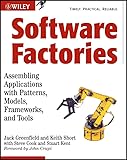Software fabrication : automating application development / Jack Greenfield and Wojtek Kozaczynski.
Material type: TextSeries: Wiley application development series | Wiley application development seriesPublication details: New York ; Chichester : Wiley, 2002.Description: 208pISBN:
TextSeries: Wiley application development series | Wiley application development seriesPublication details: New York ; Chichester : Wiley, 2002.Description: 208pISBN: - 9780471202844 (pbk.) :
- 9780471202844
- 005.1 GRE
- QA76.76.D47
| Item type | Current library | Call number | Copy number | Status | Date due | Barcode | |
|---|---|---|---|---|---|---|---|
| Long Loan | TUS: Midlands, Main Library Athlone General Lending | 005.1 GRE (Browse shelf(Opens below)) | 1 | Available | 204546 |
Preface. Acknowledgments. Foreword. Part I: Introduction to Software Factories. Chapter 1: Introduction. Chapter 2: Dealing with Complexity. Chapter 3: Dealing with Change. Chapter 4: Paradigm Shift. Chapter 5: Software Factories. Part II: Critical Innovations. Chapter 6: Models and Patterns. Chapter 7: Programming with Models. Chapter 8: Language Anatomy. Chapter 9: Families of Languages. Chapter 10: Systematic Reuse. Chapter 11: Software Product Lines. Chapter 12: Platform Based Abstractions. Chapter 13: Components and Services. Chapter 14: Mappings and Transformations. Chapter 15: Generating Implementations. Part III: Software Factories in Depth. Chapter 16: A Software Factory Example. Chapter 17: Frequently Asked Questions. Appendix A: Abstraction and Refinement. Appendix B: The Unified Modeling Language.
Software fabrication is a term coined by the author, and it combines technologies and techniques that have finally matured. The process is faster, less expensive, and yields much more reliable, maintainable applications.
